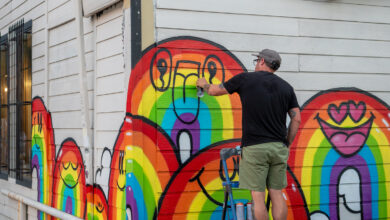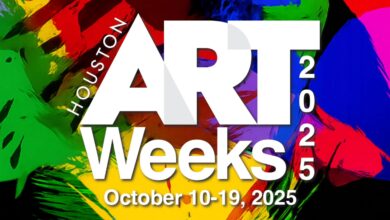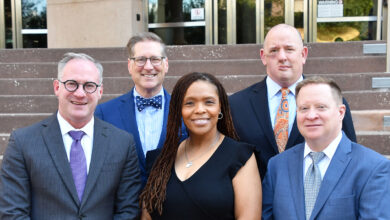
‘Ailey’ Documentary Opens in Houston This Weekend
Filmmaker Jamila Wignot discusses her highly personal portrait of the Texas-born Black gay dancer.

Documentary film director Jamila Wignot’s latest film, Ailey, is a portrait of the renowned dancer and choreographer Alvin Ailey, who founded the Alvin Ailey American Dance Theater. Wignot has created a portrait of the Texas-born, Black, gay dance-maker that is alternately exuberant and heartbreaking. She weaves together archival footage of Ailey’s earliest works with current scenes of the dance company’s rehearsals for a new work with choreographer Rennie Harris. Wignot also had access to nearly 20 hours of highly personal and revealing audio recordings that Ailey created in the last year of his life, after being diagnosed with AIDS. He died of the disease in 1989.

Ailey created works with deep roots in the Black experience by drawing on what he referred to as “blood memories,” or the ancestral memories of Black people in America. Wignot spoke with OutSmart about some of those themes, as well as the ways that her own life experiences resonate with Ailey’s. The documentary, which opens nationwide this month, screens at Houston’s Regal Edwards Greenway Grand Palace starting August 6.
Neil Ellis Orts: Writing as I am for a Texas publication, I want to start with Alvin Ailey’s childhood. I know he and his mother moved to California when he was 12, but what can you say about his time in Texas?
Jamila Wignot: It’s so clear that those years from zero to 12 were so deeply formative to him—that idea of “blood memories” is very much rooted in those rural experiences of a Black Southern life that is specific to Texas. I feel like Texas is the memory, L.A. is the early training, and New York is the space where he builds himself into the icon that we know him as today. But you can’t talk about Ailey without talking about those early years. In his first voicing of ideas, it is Texas that bubbles up, and that’s what he decides, in that initial moment, to center his works on.
Years ago, I heard dance critic Deborah Jowitt call Ailey’s Revelations one of the few truly classic, iconic modern-dance masterpieces. I know I can be flipping through a book on dance and come across that famous image of the group of dancers in a pyramid with their arms outstretched, and my breath catches.
I think there is something classic about that expression of those outstretched arms. He found a way to create, in that dance in particular, moments that are perfect for the camera. They’re so sculptural, and so expressive of something that’s universally human—that reaching for something that is beyond, that transcends every difference. It’s something that we all can feel, that yearning for something more, something better, something freer. It’s very specific to his experience, and certainly very American, but iconic. You can find similar images in religious iconography going back to the earliest of times.
I saw your film in June during a Pride Houston showing at our Montrose Center. I’m white but also grew up in rural Texas, so I marveled at Ailey’s ability to move in the sophisticated worlds he moved in, making the work he made. (Even now, I can be in an arts gathering and still feel like a hick who lacks sophistication.)
Where I grew up was not really a rural town, but it’s kind of the hick town just next door to Santa Barbara. Then I went to Wellesley, this liberal-arts college on the East Coast, and felt very out of sorts there. There is that thing of, “Who am I and what am I trying to be and where do I come from and how much of where I come from is going to stay with me?” I had white friends who were from the South who changed their accents when they came to college, to erase some of that. I think you’re putting your finger on something that is very much a part of [Ailey’s life and work]. He does choose to spaces that we’re not supposed to put center-stage. They’re the spaces we’re meant to transcend, in an American context especially. We’re supposed to transcend our working-class backgrounds, our poor backgrounds, our hick backgrounds, and move into these other spaces. But Ailey is saying no, look back at this! They’re real sources of wealth. There are the same Shakespearean levels of human drama that take place in a juke joint or a church as take place in the courts of the European royals. I don’t know that he succeeded in that for himself, in a personal way. That’s why, at the end of the film, he’s talking about this contrast of coming from where he comes from and then dancing on the Champs-Élysées. That kind of contrast is something that plagued him. As I was making the film, I kept thinking, this message of self-acceptance and self-love is so present in almost every one of his dance works. It’s a story he’s telling us, but I think it’s also a story he’s telling himself.
And of course, it’s heartbreaking to hear him speak as a conflicted gay man of his generation.
First of all, I want to say it was deeply profound to find [his very personal thoughts] in those 20 hours of audio. To think [that the only] two mentions we have of actual lovers are the two mentions he makes in those tapes. It’s interesting to [realize that] in the last year of his life, he’s thinking about his first awakening and then also this abandonment by a lover who he had such hopes could finally be a [lasting] partnership. I don’t think we can make the leap that so much of that is about shame or closeting. He wasn’t closeted to the collaborators. He was closeted to the public world. As you know from Merce Cunningham and Paul Taylor, this was not unusual for Ailey’s generation. He didn’t have the same kind of expectation of a political identity around sexuality that he certainly did have around race. There’s a lot that we can’t assume about his experience. I didn’t want the film to make those assumptions. I wanted you to know that he experienced struggle, but I [also] wanted to center the experience of being Black and having spaces of joy. With his sexuality, I just wanted you to hear him talk, because it’s so remarkable that he did [open up], in his last year, about these two foundational experiences. I prioritized [creating] an experiential journey, along with wanting to leave space for you, as a viewer, to come to your own conclusions.
Buy tickets for Ailey’s Houston screening here. For more streaming information on the documentary, go here.










